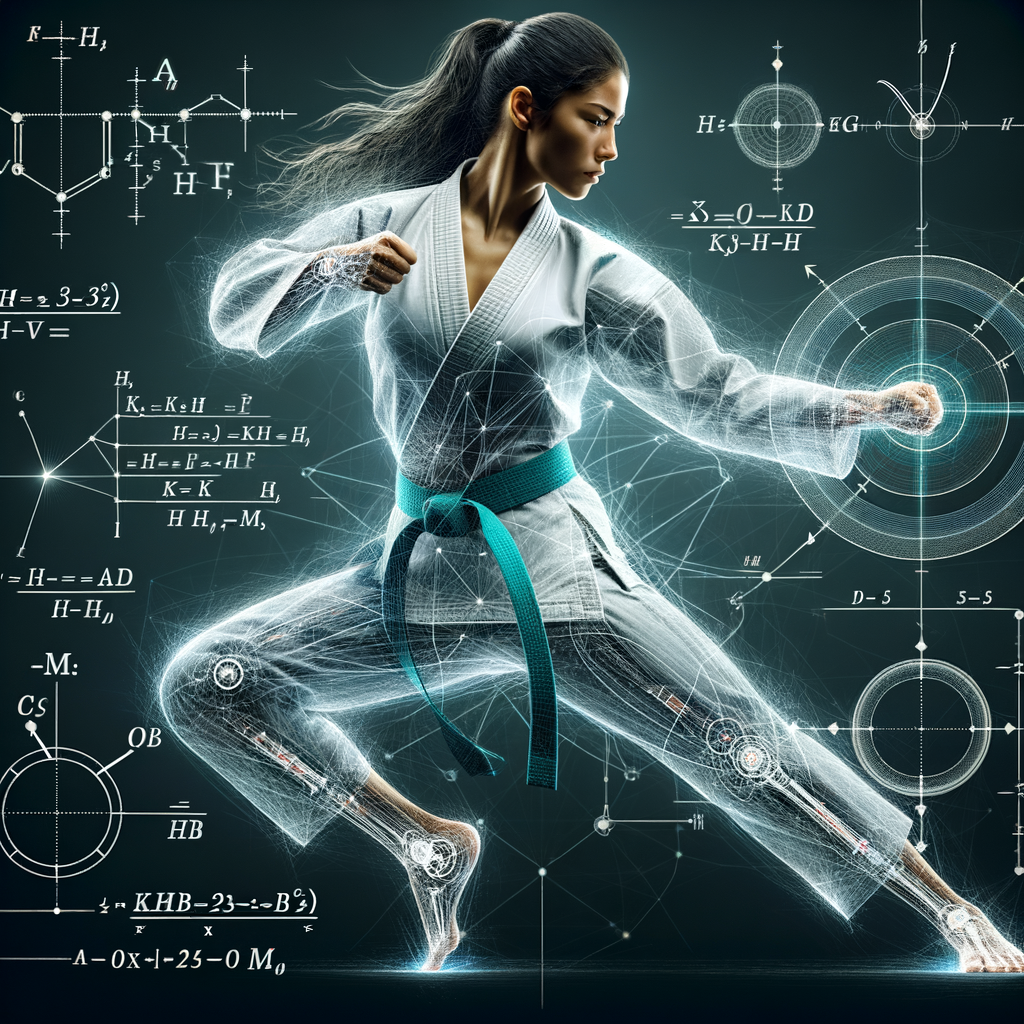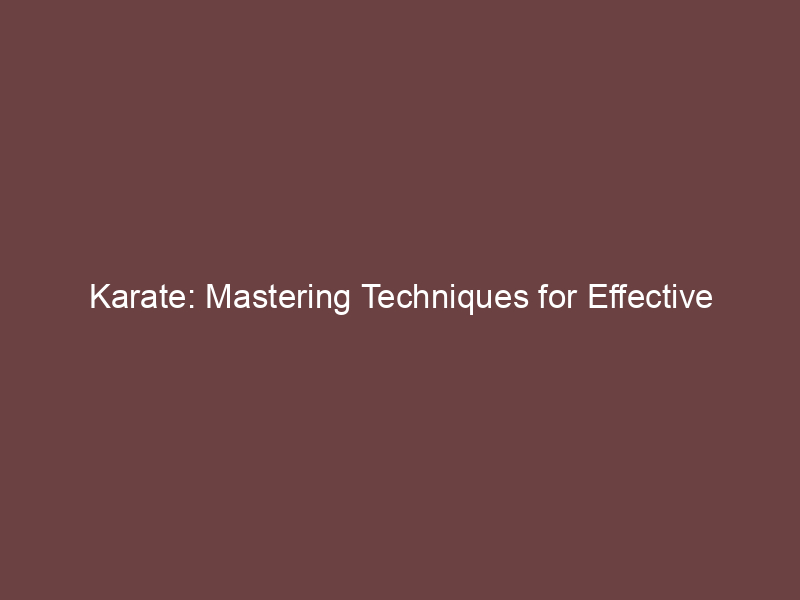
The Science Behind Karate Techniques: An Introduction
A popular martial art that originated in Japan. It involves various techniques like punches, kicks, and blocks. But did you know that science plays a big role in how these techniques work? Let’s dive into the basics of Karate and see how science helps in martial arts.
-
- The basics of Karate
It teaches discipline, respect, and self-control. The main goal is to defend yourself while staying calm and focused. Karate uses different stances and movements to create powerful strikes and blocks. Each move is carefully practiced to make it perfect.
-
- How science plays a role in martial arts
Helps us understand how our bodies move and react. In Karate, this is very important. For example, physics explains how force and momentum work in a punch or kick. Biology helps us understand how muscles and bones work together to create strong movements. By studying these sciences, Karate practitioners can improve their techniques and avoid injuries.
Biomechanics of Martial Arts
Karate Biomechanics
- The science of movement in KarateIit helps us understand how to punch, kick, and block effectively. For example, when you punch, your whole body should work together. Your legs, hips, and arms all play a part. This makes your punch stronger and faster.
- How biomechanics enhances Karate techniquesFor instance, by studying how muscles and joints work, they can learn to move more efficiently. This reduces the risk of injury and increases power. Biomechanics also helps in perfecting stances and movements, making them more effective in both practice and competition.
Martial Arts Physics
-
Applying Principles of Physics in Martial Arts
It helps us understand how forces work. For example, when you punch, you use force. The harder you punch, the more force you use. This is called Newton’s Second Law of Motion.
Another principle is momentum. Momentum is the product of mass and velocity. In simple terms, it means how much “oomph” your punch has. A heavier person or a faster punch means more momentum.
Gravity also affects martial arts. When you jump or kick, gravity pulls you back down. Knowing how to use gravity can make your moves stronger.
By understanding these principles, you can improve your martial arts skills. You can punch harder, move faster, and use your body more efficiently.
- Leverage: Using leverage can make your moves stronger. For instance, when you twist your hips during a punch, you use leverage to add power.
- Center of Mass: Keeping your center of mass low helps you stay balanced. This makes it harder for opponents to knock you down.
- Energy Transfer: When you punch, you transfer energy from your body to your fist. The more energy you transfer, the stronger your punch.
How Physics Can Improve Your Karate Technique
-
Physics Principle How It Helps in Karate Leverage Adds power to moves Center of Mass Improves balance Energy Transfer Increases punch strength By using physics, you can make your Karate techniques more effective. Practice these principles to become a better martial artist.
Karate Technique Analysis
Breaking Down Karate Moves
- Scientific study of Karate punches: They involve speed, accuracy, and timing. Scientists have studied how a punch can deliver maximum force. According to a study, a punch’s power comes from the whole body, not just the arm. The hips and legs play a big role in generating force.
- Analysis of Karate kicks: They require balance and flexibility. Studies show that the speed of a kick can reach up to 30 miles per hour. The most common kicks in Karate are the front kick, side kick, and roundhouse kick. Each kick uses different muscles and techniques.
| Karate Move | Key Elements | Scientific Insight |
|---|---|---|
| Punch | Speed, Accuracy, Timing | Whole body generates force |
| Front Kick | Balance, Flexibility | Speed can reach 30 mph |
| Side Kick | Precision, Power | Uses different muscles |
| Roundhouse Kick | Technique, Speed | Involves hip rotation |
Case Study: Karate vs. Other Martial Arts
-
Comparing the Biomechanics of Karate and Taekwondo
Karate and Taekwondo are both popular martial arts. They have some similarities but also many differences.
Karate focuses on powerful, direct strikes. It uses straight punches and kicks. The stances are firm and grounded. This helps in delivering strong blows.
Taekwondo emphasizes speed and agility. It has many high, jumping kicks. The stances are lighter and more flexible. This allows quick movements and fast attacks.
Aspect Karate Taekwondo Main Focus Power and precision Speed and agility Stances Firm and grounded Light and flexible Common Techniques Straight punches, low kicks High kicks, jumping kicks Both martial arts have their own strengths. Karate is great for building strength. Taekwondo is excellent for improving speed.
-
How Karate Techniques Differ from Boxing
Karate and Boxing are both combat sports. But they use different techniques and strategies.
Karate uses a mix of punches, kicks, and blocks. The movements are often linear. Karate fighters use their whole body to generate power.
Boxing focuses mainly on punches. Boxers use jabs, hooks, and uppercuts. They move in a circular manner. Footwork is very important in boxing.
Aspect Karate Boxing Main Techniques Punches, kicks, blocks Punches only Movement Linear Circular Footwork Less emphasized Highly emphasized Karate is good for learning a variety of techniques. Boxing is excellent for mastering punches and footwork.
Karate Training Science
Applying Science to Karate Training
- How physics can improve your trainingWhen you punch or kick, you use force and motion. By understanding how these work, you can make your moves stronger and faster. For example, knowing how to use your body weight can add power to your punches. This is called “momentum.” The more you know about physics, the better you can train.
- Biomechanics for injury prevention in KarateUsing the right techniques can help you avoid injuries. For instance, bending your knees slightly when you punch can protect your joints. Also, keeping your back straight can prevent back pain. Learning about biomechanics can help you train safely and effectively.
Key Takeaways for Karate Practitioners
- How to apply these scientific principles in your practice:
Understanding the science behind Karate can help you improve your skills. For example, knowing how your muscles work can make your punches stronger. You can also use physics to understand how to balance better during kicks.
Here are some tips to apply science in your practice:
-
- Focus on Biomechanics: Learn how your body moves. This can help you avoid injuries and perform better.
- Use Physics: Think about force and motion. This can help you make your moves more powerful.
- Practice Regularly: The more you practice, the better you get. Use scientific principles to guide your practice sessions.
-
Improving your Karate techniques with science:
Science can make your Karate techniques better. For example, understanding how your body works can help you punch faster and kick higher.
Here are some ways to improve your techniques:
- Analyze Your Moves: Watch videos of yourself. Look for ways to make your moves smoother and stronger.
- Get Feedback: Ask your coach for tips. They can help you understand what you are doing right and what you need to improve.
- Stay Healthy: Eat well and get enough sleep. A healthy body performs better.
Conclusion: The Science Behind Karate Techniques
- Recap of the scientific principles in Karate:Karate is not just about strength. It uses science to make moves more effective. We talked about biomechanics, which is how our bodies move. We also looked at how muscles and bones work together. Understanding these helps in making powerful and precise moves.
- How this knowledge can enhance your martial arts practice:Knowing the science behind Karate can make you a better martial artist. When you understand how your body works, you can improve your techniques. This can help you avoid injuries and become more efficient. For example, using the right muscles can make your punches stronger. Also, knowing how to balance can make your stances more stable.
| Key Insight | Benefit |
|---|---|
| Biomechanics | Improves movement efficiency |
| Muscle and Bone Coordination | Enhances power and precision |
| Balance and Stance | Increases stability and reduces injury |
Understanding the science behind Karate techniques can greatly improve your practice. It helps you move better, hit harder, and stay safe. Keep learning and applying these principles to become a skilled martial artist.






